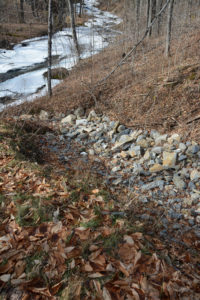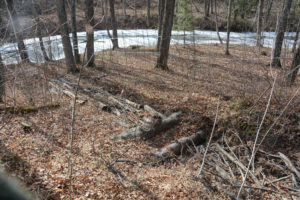A Vermont Farmer's Last Resort
by Julianne Lovergine
This farmer worked his way across the country and back, finally landing in Vermont.
From Massachusetts, to California, to Tennessee, this farmer worked his way across the country and back, finally landing in Vermont. “I missed the seasons in New England,” he says. Together, Sam Burr and his wife Eugenie Doyle searched for the perfect spot to begin their first independent farming operation, but understood that starting out can be challenging. So, when they came across a house that rattled and shook when the granite trucks passed, with a barn across a busy road, and another family in the shed with no running water, it seemed like a last resort.

Sam Burr is owner and operator of Last Resort Farm in Monkton, Vermont, where he has worked with conservation partners to help stabilize soil erosion in an effort to protect and improve water quality.
Sam and Eugenie’s adventure with Last Resort Farm began in 1980, as a small conventional dairy farm in Brookfield, Vermont. They later relocated to Monkton and bought a larger herd of registered Jersey cows, but chronically low milk prices drove them to sell the herd in 1994, turning their focus to hay, vegetable and berry crops. With a young family, health and safety as a concern, as well as seeing a market niche, they transitioned to organic and became certified.
Ninety of the 279 acres on the farm are tillable with 80 acres in hay, over 6 acres in berries and vegetables, and several more in cover crops. They farm with their son, Silas, a couple of full-time seasonal employees, and several part-time helpers. Their berry specialties consist of strawberries, raspberries, blueberries, currants, and gooseberries. Vegetables include asparagus in the spring, greens, beets, carrots, garlic, onions, corn, and tomatoes in the summer, and potatoes, sweet potatoes, squash, pumpkins and fresh ginger in the fall. Silas has also been working on an aquaponics project raising rainbow trout and basil in the barn.
The Doyle-Burrs specialize in garlic, growing 1500 pounds annually. “Garlic is a fascinating crop,” Sam says. “If you take the same variety, and grow it in different places, it will look different both because it takes up nutrients in the soil like iron, that will make it very red, and due to growing season length, it may develop a totally different number of cloves on each bulb, and acclimates itself to the farm where it has been grown.”
The diversified family farm focuses on local markets, selling to area co-ops, small groceries, restaurants, and the Richmond and Winooski farmers markets. Nearly 100% of their produce is sold within 20 miles of their farm. They also provide pick-your-own berries in the summer, a year round farm stand, and a farm share program that allows members to come to the farm and select the produce of their choosing. “The farm share program is our version of a CSA. They give us $100 and we give them a card with $110 on it and they come to the farm and pick out what they like,” says Sam.

USDA-NRCS worked with Sam through the EQIP Farm Bill program to install traditional engineering practices, like stone, to stabilize gullies that were contributing to impaired water quality. The benefits to this approach include proven success in combating erosion, and a longer life span due to the durability of the materials.
As with many farms, eventually some improvements were needed on the land. In 2012, water quality monitoring systems detected an impaired section of Pond Brook, which was identified as the largest contributing tributary for nutrient loading into the Lewis Creek Watershed. The Lewis Creek Association later conducted field assessments and found a number of large gullies on Last Resort Farm. “These gullies were starting to eat into the fields,” Sam explains. “Plus you could see when there was a weather event, the brook was sullied.” His awareness of water quality degradation in Lake Champlain and the contribution of agricultural runoff, combined with his conservation stewardship, led him to research what he could do to protect soil and water on his own farm.
In an effort to explore and compare the effectiveness of different conservation practices, two techniques were used to reduce gully erosion on the farm. Working through the Vermont Agency of Natural Resources (ANR) Ecosystem Restoration Program, the Lewis Creek Association received a grant to install ‘soft engineering’ in one of the gullies. Also referred to as ‘engineering with nature,’ it is an alternative to more traditional materials, such as stone (rip rap). This gully was treated with softer, hand placed materials, including brush and small logs, and used grading and gully shaping to reduce water velocity. Benefits of this approach include a more natural appearance, reduced cost, and less disturbance, but it may require more maintenance, and not last as long as more traditional materials.
In contrast, the USDA Natural Resources Conservation Service (NRCS) provided technical and financial assistance to help stabilize three of the gullies utilizing more traditional engineering practices and materials. Through NRCS’ Environmental Quality Incentives Program (EQIP), Sam worked with Soil Conservationist Marybeth Whitten and Soil Conservation Technician Pete Lossmann to install a rock-lined water-way practice, ensuring that the most critical gullies were stabilized. The benefits to this approach include proven success in combating erosion, and a longer life span due to the durability of the materials.

Working through the Vermont Agency of Natural Resources (ANR) Ecosystem Restoration Program, Sam worked with the local Lewis Creek Association who received a grant to install ‘soft engineering’ in one of his gullies. It was treated with softer, hand placed materials, including brush and small logs, and used grading and gully shaping to reduce water velocity.
The application of these diverse engineering techniques will serve as a good demonstration in the effectiveness, durability, and lifespan of different methods. Sam initially felt that bringing in the stone to fill the gullies with large machinery might be an issue. “These are pretty sensitive areas anyway, so you have the potential to create problems at a time you are trying to solve problems,” he says. “But they were able to time it appropriately; that winter we had enough frost in the ground and not too much snow. We were able to get heavy trucks through successfully and operate the excavators on the steep banks with minimal disturbance.” The stabilized gullies have been in place for about a year now, and the two approaches will be monitored through photographic documentation at specific set points.
Sam feels strongly about protecting the environment. He currently serves on a town committee that reviews applications for town funds to help finance conservation projects. “Some of the farms here have been reluctant to work with government programs – and so by trying to show people that there’s assistance available, and everybody is working toward the same goal, and given the new legislation requiring farmers to protect water quality, we’re trying to work with our neighbors to see what we can do to improve the quality of the water in the brook.”
Sam and Eugenie have been farming for over 30 years – a long stretch for some. But when asked why he rises each morning and goes outside every day, Sam replies: “We feel very fortunate to be here. The family that was here before us was here for five generations. This farm is a real resource and a beautiful resource, so, making it sustainable and keeping it going is why we’re here. It’s been a real home for us, we raised our three kids here, and we feel very fortunate.”
“Sam’s involvement and input throughout the project helped to shape it and make it a success. His work ethic and stewardship of the land leave me with no doubt that the Doyle-Burrs will be on this land for five generations, just like the previous family,” said Lossman.”
For more information about conservation programs and assistance, contact your local NRCS office or visit www.nrcs.usda.gov.
Julianne Lovergine is an Eco AmeriCorps Member and NRCS Conservation Assistant in Williston, VT.

